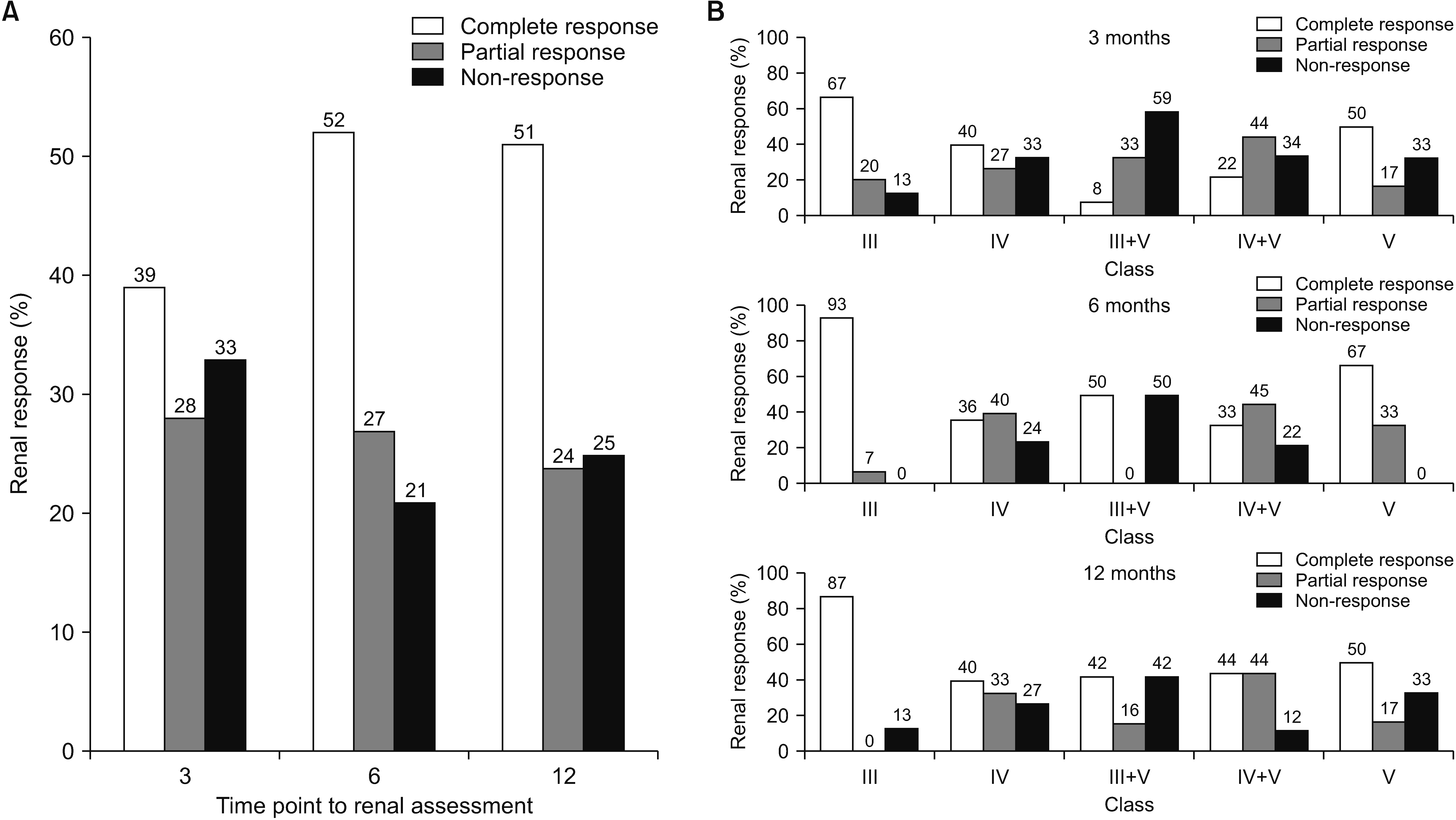Abstract
Objective
Methods
Results
Notes
FUNDING
Dr. Sang-Cheol Bae (corresponding author) is supported by the Basic Science Research Program through the National Research Foundation of Korea funded by the Ministry of Education (NRF-2021R1A6A1A03038899).
CONFLICT OF INTEREST
Young Bin Joo has been an Editorial Board member of the Journal of Rheumatic Diseases since 2022. But she did not involve in the peer review process. Except for that, no potential conflict of interest relevant to this article was reported.
AUTHOR CONTRIBUTIONS
S.C.B. contributed to the conception and design of the study, data collection, and data analysis. D.J.P., Y.B.J., J.Y.L., S.Y.B., and H.S.L. contributed to data analysis and interpretation. All authors were involved in manuscript preparation and review and approved the final version for publication.
REFERENCES
Fig. 1

Table 1
| n=75 | |
|---|---|
| Female sex | 68 (90.7) |
| Age at enrollment (yr) | 34.9±9.8 |
| Age at diagnosis of SLE (yr) | 23.8±7.8 |
| Age at diagnosis of LN (yr) | 28.9±9.7 |
| LN duration (yr) | 6.0±6.5 |
| SLE duration (yr) | 11.9±5.9 |
| Renal flare | |
| 1st | 33 (44.0) |
| 2nd | 31 (41.3) |
| 3rd | 10 (13.3) |
| 4th | 1 (1.3) |
| Laboratory findings | |
| WBC count (cells ×103/mm3) | 5.7±2.4 |
| Neutrophil count (cells ×103/mm3) | 4.2±2.2 |
| Lymphocytes (cells ×103/mm3) | 1.1±0.7 |
| Creatinine (mg/dL) | 0.7±0.3 |
| eGFR (mL/min/1.73 m2) | 110.1±25.8 |
| Active urinary sediment* | 70 (93.3) |
| C3 (g/L) | 52.3±18.6 |
| Decreased C3 | 71 (94.7) |
| C4 (g/L) | 9.3±6.8 |
| Decreased C4 | 52 (69.3) |
| Proteinuria (mg/day) | 2,639.9±2,408.5 |
| Sub-nephrotic range | 54 (72.0) |
| Nephrotic range | 21 (28.0) |
| Positivity for auto-antibody | |
| Anti-dsDNA | 53 (70.7) |
| Anti-Sm | 30 (40.0) |
| Anti-Ro | 47 (62.7) |
| Anti-La | 11 (14.7) |
| Antiphospholipid antibody | |
| Lupus anticoagulant antibody | 9 (12.0) |
| Anti-Cardiolipin IgM & IgG antibody | 5 (6.7) |
| β2-GP1 IgM & IgG antibody | 3 (4.0) |
| APL antibody† | 12 (16.0) |
| SLEDAI | 15.6±4.6 |
| Hypertension | 8 (10.7) |
| Induction treatment | |
| MMF | 55 (73.3) |
| MMF+TAC | 12 (16.0) |
| TAC | 2 (2.7) |
| Others‡ | 6 (8.0) |
Values are presented as number (%) or mean±standard deviation unless otherwise indicated. SLE: systemic lupus erythematosus, LN: lupus nephritis, WBC: white blood cells, eGFR: estimated glomerular filtration rate, C3: complement 3, C4: complement 4, Anti-dsDNA: anti-double-stranded deoxyribonucleic acid, Anti-Sm: anti-Smith, IgM: immunoglobulin M, IgG: immunoglobulin G, β2-GP1: β2-glycoprotein 1, APL antibody: antiphospholipid antibody, SLEDAI: Systemic Lupus Erythematosus Disease Activity Index, MMF: mycophenolate mofetil, TAC: tacrolimus, RBC: red blood cell, HPF: high power field. *>5 RBC or WBC/HPF and/or ≥1 cellular cast. †Have at least one antiphospholipid antibody. ‡Cyclosporine, Rituximab, and Steroid only, number (%): 1 (1.3), 1 (1.3), and 4 (6.7), respectively.
Table 2
Table 3
| Variable | Univariate regression | Multivariate regression | |||||
|---|---|---|---|---|---|---|---|
| OR | 95% CI | p-value | OR | 95% CI | p-value | ||
| Female sex | 1.07 | 0.59~1.94 | 0.820 | 1.09 | 0.62~1.92 | 0.759 | |
| Age at enrollment | 1.02 | 1.01~1.04 | 0.003 | 1.02‡ | 1.00~1.04‡ | 0.022‡ | |
| Age at diagnosis of SLE | 1.03 | 1.01~1.05 | 0.006 | ||||
| Age at diagnosis of LN | 1.02 | 1.01~1.04 | 0.001 | ||||
| LN duration | 1.00 | 0.98~1.02 | 0.997 | ||||
| SLE duration | 1.02 | 1.00~1.04 | 0.073 | 1.00 | 0.98~1.02 | 0.912 | |
| Relapsed LN | 0.71 | 0.51~1.00 | 0.051 | 0.71‡ | 0.51~0.98‡ | 0.037‡ | |
| Laboratory findings | |||||||
| Creatinine | 0.61 | 0.26~1.47 | 0.270 | ||||
| eGFR | 1.00 | 1.00~1.01 | 0.545 | ||||
| C3 | 1.00 | 1.00~1.01 | 0.975 | ||||
| C4 | 1.00 | 0.97~1.02 | 0.778 | ||||
| Proteinuria | 1.00 | 1.00~1.00 | 0.241 | ||||
| Positivity of auto-antibody | |||||||
| Anti-dsDNA | 1.14 | 0.76~1.70 | 0.524 | ||||
| Anti-Sm | 0.84 | 0.58~1.22 | 0.356 | ||||
| Anti-RNP | 1.09 | 0.78~1.53 | 0.612 | ||||
| Anti-Ro | 0.76 | 0.55~1.04 | 0.084 | 0.67‡ | 0.49~0.92‡ | 0.014‡ | |
| Anti-La | 1.12 | 0.75~1.66 | 0.583 | ||||
| APL antibody* | 0.67 | 0.33~1.37 | 0.273 | ||||
| Renal histology (ISN/RPS) | |||||||
| Activity index | 0.97 | 0.92~1.02 | 0.203 | ||||
| Chronicity index | 0.98 | 0.89~1.09 | 0.765 | ||||
| Class III† | 1.64 | 1.28~2.10 | <0.001 | 1.48‡ | 1.17~1.87‡ | 0.001‡ | |
| SLEDAI | 1.00 | 0.97~1.04 | 0.947 | ||||
| Hypertension | 0.93 | 0.52~1.69 | 0.820 | ||||
OR: odds ratio, 95% CI: 95% confidence interval, SLE: systemic lupus erythematosus, LN: lupus nephritis, eGFR: estimated glomerular filtration rate, C3: complement 3, C4: complement 4, Anti-dsDNA: anti-double-stranded deoxyribonucleic acid, Anti-Sm: anti-Smith, Anti-RNP: anti-ribonucleoprotein, APL antibody: antiphospholipid antibody, ISN/RPS: International Society of Nephrology/Renal Pathology Society, SLEDAI: Systemic Lupus Erythematosus Disease Activity Index. *Have at least one antiphospholipid antibody. †Class III vs. class III+V, IV, IV+V, and V. ‡Values are considered significant.




 PDF
PDF Citation
Citation Print
Print



 XML Download
XML Download